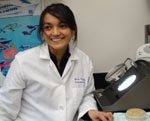|
by Mary Helen Yarborough
Public Relations
In pursuit of antibiotic resistant bacterial infections, MUSC
scientists, their collaborators at North Carolina State University
(NCSU), and the Hollings Marine Laboratory (HML) have found astonishing
disease-fighting potential by investigating the resilient sea sponge.
Their findings through joint research between MUSC, NCSU and the
National Oceanic and Atmospheric Administration (NOAA), could open new
therapies for treating antibiotic resistant infections, cancer, and
fungal infections.
The discovery of how some bacteria protect themselves in the presence
of a compound they produce called “biofilm” has spotlighted a novel
weakness in the bacteria’s survival mechanism.
Scientists looked at how a sea sponge was thriving amid an otherwise
bleak environment surrounded by dying coral. They identified a compound
that the sponge produces that removes bacterial biofilms and inhibits
biofilm production that resistant bacteria use to protect themselves
from physical and chemical insults, such as antibiotics. Removing a
bacteria’s biofilm’s naturally-protective properties can result in a
“re-sensitization” to antibiotic activity.
Between 65 percent and 80 percent of bacterial infections are
biofilm-based, according to Pete Moeller, Ph.D., an HML-based NOAA
scientist involved in the multi-institutional study.
Researchers have known for some time that the biofilms produced by
resistant bacteria provide effective protection against antibiotics. By
removing the biofilm, these compounds provide an open door for a
stealth attack on the bacteria.
These resistant bacteria include Pseudomonas auriginosa, the causative
agent of mortality in cystic fibrosis patients; methicillin resistant
staphylococcus aureus (MRSA); and the killer bacteria—multi-drug
resistant Acinetobacter baumannii (MDRAB), said Moeller.
A number of MDRAB are reported to be resistant to all known
currently-used antibiotics, Moeller said. “It is one of the most deadly
bacteria known. But (NCSU) colleagues killed it in two-to-four hours by
removing its biofilm mechanism so antibiotics could perform. NCSU
colleagues leading this program have yet to find a biofilm-producing
bacterium that cannot be re-sensitized to current generation
antibiotics.”
In addition to developing these new chemical tools and using them to
fight the antibiotic resistance war, Moeller said, “... We can also
isolate new medicines from the marine environment that can be
customized to individuals’ needs rather than relying on broad spectrum
antibiotics, or non-specific anti-cancer agents.
“This could lead to a new class of helper drugs and result in a rebirth
for antibiotics no longer thought effective,” Moeller told an assembly
of the American Association for the Advancement of Science. “Its
potential application to prevent biofilm build-up in stents,
intravenous lines and other medical uses is incredible.”
The compound is currently being tested for a variety of medical uses
and has gone through a second round of sophisticated toxicity screening
and so far shows no toxic effects. Now, if only more funding was
available for the research and trials, Moeller added.
Looking for novel germs
Maria Vizcaino, an MUSC doctoral student at HML, had been searching for
novel marine antibiotics to treat antibiotic resistant bacteria, and
believed that clues exist in the oceanic frontier being opened by
Moeller’s research.
 For
her work, Maria Vizcaino was awarded a 2009 American Society for
Microbiology Cooperative Activities Program Student Travel Grant to
attend the 109th General Meeting in Philadelphia, Pa. For
her work, Maria Vizcaino was awarded a 2009 American Society for
Microbiology Cooperative Activities Program Student Travel Grant to
attend the 109th General Meeting in Philadelphia, Pa.
In
2006, Vizcaino’s co-mentor, Pam Morris, Ph.D., of MUSC’s Marine
Biomedicine and Environmental Sciences Center, obtained a National
Science Foundation grant to characterize microoganisms associated with
Caribbean corals. This project provided Vizcaino and her mentors,
Morris and Moeller, the marine bacteria to screen for novel activities.
“Maria started screening bacteria associated with a Caribbean coral for
their potential in producing antimicrobial compounds,” Morris said.
“And she began to look more closely at the pathogen (Vibrio
coralliilyticus) that is a coral pathogen.”
Vizcaino isolated a relatively unstudied bacterium from the
Pseudovibrio genus that is associated with a lot of the marine
invertebrates that is helping saltwater fish grow healthier and
stronger through enhanced immunity, said NOAA’s Susan Lovelace, Ph.D.,
a scientist with an HML lab and project.
Vizcaino has started to isolate and characterize the antibiotic
compounds that she anticipates are novel. Her findings could lead to
cures to the world’s most daunting diseases, including cancer,
antibiotic-resistance and viruses.
For her work (Characterization of Marine Antimicrobial Compounds from a
Pseudovibrio sp. Associated with the Surface Mucopolysaccharide Layer
of a Caribbean Coral), Vizcaino has been awarded a 2009 American
Society for Microbiology (ASM) Cooperative Activities Program Student
Travel Grant to attend the ASM’s 109th General Meeting in Pennsylvania,
May 17-21. (See http://www.musc.edu/mbes)
Friday, April 10, 2009
|



